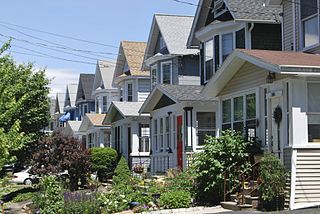
Albany is the capital and oldest city in the U.S. state of New York and the seat of and the most populous city in the county of the same name. It is located on the west bank of the Hudson River, about 10 miles (16 km) south of its confluence with the Mohawk River, 135 miles (220 km) north of New York City, 170 miles (270 km) west of Boston, and about 220 miles (350 km) south of Montreal.
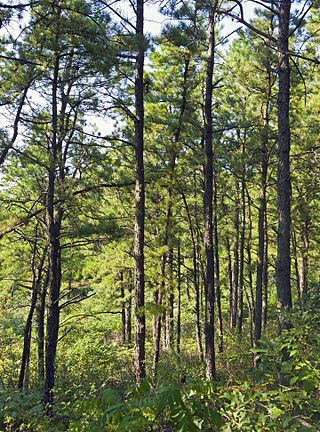
The Albany Pine Bush, referred to locally as the Pine Bush, is one of the largest inland pine barrens in the world. It is centrally located in New York's Capital District within Albany and Schenectady counties, between the cities of Albany and Schenectady. The Albany Pine Bush was formed thousands of years ago, following the drainage of Glacial Lake Albany.
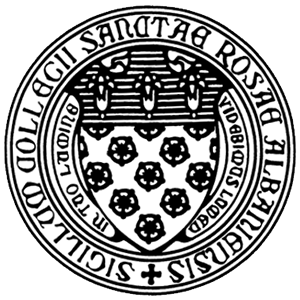
The College of Saint Rose is a private Catholic college in Albany, New York. It was founded in 1920 by the Sisters of St. Joseph of Carondelet as a women's college. It became fully co-educational in 1969. The following year, the college added laypersons to its board and became an independent college sponsored by the sisters. The college is in the Pine Hills neighborhood of Albany. It is a Division II member of the National Collegiate Athletic Association (NCAA).
Crossgates Mall is an enclosed, automobile-oriented, super-regional shopping mall located in the Albany, New York suburb of Guilderland. It is the largest indoor shopping center in the Capital District, and the third largest in the State of New York. The mall is anchored by retailers Macy's, JCPenney, Dick's Sporting Goods, Primark, Burlington, and Best Buy.

The Cromwell Las Vegas is a luxury boutique casino hotel on the Las Vegas Strip in Paradise, Nevada. It is owned and operated by Caesars Entertainment. It was originally opened by Michael Gaughan as the Barbary Coast on March 2, 1979. Several nearby resorts were opposed to its construction, partially due to concerns about increased traffic congestion. The property featured Victorian décor and later became part of Gaughan's company, Coast Casinos. The Barbary Coast would go on to add two popular restaurants, and a nightclub by Victor Drai.

The Port of Albany–Rensselaer, widely known as the Port of Albany, is a port of entry in the United States with facilities on both sides of the Hudson River in Albany and Rensselaer, New York. Private and public port facilities have existed in both cities since the 17th century, with an increase in shipping after the Albany Basin and Erie Canal were built with public funds in 1825.

Matthew Scott Murphy is an American entrepreneur and politician. He represented parts of New York state's Capital District in the United States House of Representatives for a portion of one term from April 2009 until January 2011. He was defeated for election to a full term on November 2, 2010.
The history of Albany, New York, began long before the first interaction of Europeans with the native Indian tribes, as they had long inhabited the area. The area was originally inhabited by an Algonquian Indian tribe, the Mohicans, as well as the Iroquois, five nations of whom the easternmost, the Mohawk, had the closest relations with traders and settlers in Albany.

Union Station, also known as Albany Union Station, is a building in Albany, New York, on the corner of Broadway and Steuben Street. Built during 1899–1900, it served originally as the city's railroad station but now houses credit union offices. It was listed on the National Register of Historic Places (NRHP) during 1971.
Westgate Plaza is a large strip mall in the city of Albany, New York, located on Central Avenue. Westgate is considered the first mall in the Albany area, and opened in 1957.

The W. Averell Harriman State Office Building Campus is an office park in western Albany, New York, United States that houses sixteen New York State Government office buildings. The land totals roughly 330 acres (130 ha) and over 3 million square feet of office space, and about 7,000 state employees work there. The campus was built during the 1950s and 1960s in a suburban, car-oriented style bordered by an outer ring road that cuts the campus off from the surrounding neighborhoods. The campus is flanked by Washington Avenue to the north, Western Avenue to the south, University at Albany to the west, and New York State Route 85 to the east. With its own steam generation power plant for cooling and heating the campus is mostly self-sufficient.

Wellington Row is a row of buildings along the south side of State Street in Albany, New York. It spans from 132 to 140 State Street and includes the Wellington Hotel, its namesake, the former Elks Lodge No. 49, former Berkshire Hotel, and a couple of row houses south of the Wellington Hotel. The Wellington Hotel included a second building called the Wellington Annex on Howard Street with an attached garage that both faced towards the back of Wellington Row. The row was placed on the Preservation League of New York State's Seven to Save list for the year 2000. The entire row is part of the Downtown Albany Historic District.
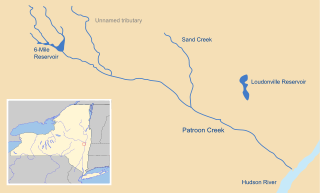
Patroon Creek is a stream in Albany County, New York, United States and is a tributary of the Hudson River which flows south to New York Harbor and the Atlantic Ocean. The creek's source is Rensselaer Lake in the western section of the city of Albany. Patroon Creek received its name from the patroon of Rensselaerswyck.

Downtown Schenectady is the central business district for the city of Schenectady, New York. It originated in the 1820s with the moving of the commercial and industrial interests east from the original 17th and 18th century settlement, spurred on by the development of the Erie Canal. Home to the headquarters and major manufacturing plants of two large corporations, General Electric and American Locomotive Company, Downtown Schenectady catered to tens of thousands of workers in its heyday. Typical of the post-industrial Northeastern United States and Upstate New York in particular, Downtown Schenectady saw a decline in manufacturing and population starting in the 1970s. Recent construction and renovation has caused the downtown area to become an entertainment mecca for New York's Capital District anchored by Proctor's Theatre.
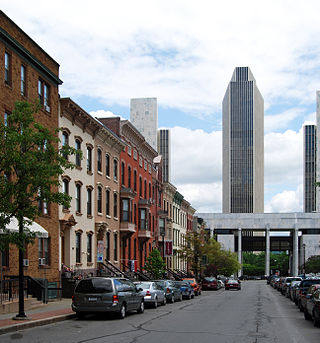
The architecture of Albany, New York, embraces a variety of architectural styles ranging from the early 18th century to the present. The city's roots date from the early 17th century and few buildings survive from that era or from the 18th and early 19th century. The completion of the Erie Canal in 1825 triggered a building boom, which continued until the Great Depression and the suburbanization of the area afterward. This accounts for much of the construction in the city's urban core along the Hudson River. Since then most construction has been largely residential, as the city spread out to its current boundaries, although there have been some large government building complexes in the modernist style, such as Empire State Plaza, which includes the Erastus Corning Tower, the tallest building in New York outside of New York City.

North Albany is a neighborhood in the city of Albany, New York. North Albany was settled in the mid-17th century by the Patroon of Rensselaerswyck and his tenants and later became a hamlet in the town of Watervliet. Due to the Erie Canal being constructed in 1825, North Albany saw immense growth, with the Albany Lumber District and an influx of Irish immigrants lending the area the name of Limerick. Home to many historic warehouses and row houses, North Albany continues to be an important industrial neighborhood. Recent efforts have begun to gentrify the neighborhood by adapting heavy industry/warehouse use to artistic and entertainment venues, such as a German beer garden, an amusement park, live music venues, and arts and crafts marketplaces.
Pine Hills is a neighborhood in Albany, New York, generally defined as the area from Manning Boulevard to the west, Woodlawn Avenue to the south, Lake Avenue to the east, and Washington Avenue to the north. The neighborhood consists mainly of freestanding multi-unit, duplex, and semi-detached houses and is home to Albany High School, the LaSalle school, the College of St. Rose, and the Alumni Quad of the University at Albany. Though mostly residential due to historical reasons from its founding, Pine Hills is home to two neighborhood commercial districts ; Middle Madison, from Partridge to Quail streets was designated first, and then a latter designated district, Upper Madison, from Main Avenue to North Allen Street. The area of Pine Hills east of Main Avenue and north of Myrtle Avenue is commonly referred to as the student ghetto due to its predominant population of college-age students. The area of Pine Hills west of Main Avenue features many large Queen Anne, Folk Victorian, and Colonial Revival homes. Upper Madison, where it meets Western Avenue near St. Rose is the center of a commercial area, complete with a movie theater, grocery store, fast food strip mall, retail, restaurants, a library, community playhouse, police station, pharmacy, and elementary school.
The history of Albany, New York from 1983 to present begins with the death of Erastus Corning 2nd, Albany's longest serving mayor. When Corning died in 1983, Thomas Whalen assumed the mayorship and was reelected twice. Albany saw a significant influx of federal dollars earmarked for restoring historic structures. What Corning had saved from destruction, Whalen refurbished. The Mayor's Office of Special Events was created in an effort to increase the number of festivals and artistic events in the city, including a year-long Dongan Charter tricentennial celebration in 1986. Whalen is credited for an "unparalleled cycle of commercial investment and development" in Albany due to his "aggressive business development programs".

Tricentennial Park is an urban park in Albany, New York built to commemorate that city's three hundredth anniversary as an incorporated city and is the site of several statues and monuments. The park encompasses the entire block bounded by Broadway to the east, Columbia Street to the north, James Street to the west, and Steuben Street to the south. First proposed in 1914 it was built in 1986 as part of the tricentennial celebrations of Albany's incorporation as a city in association with the renovation of the Albany Union Station.
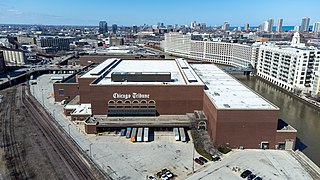
Freedom Center, also known as the Chicago Tribune Publishing Center, is the printing plant and headquarters for the Chicago Tribune, as well as the printing facility for other publications such as the Chicago Sun-Times.





















